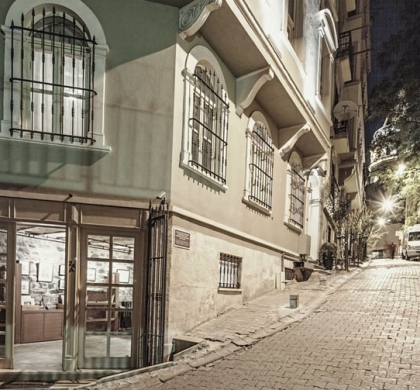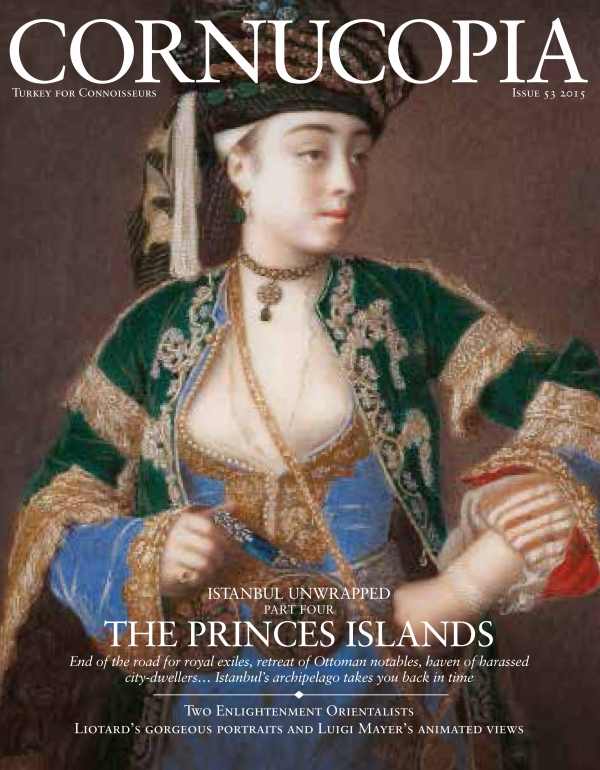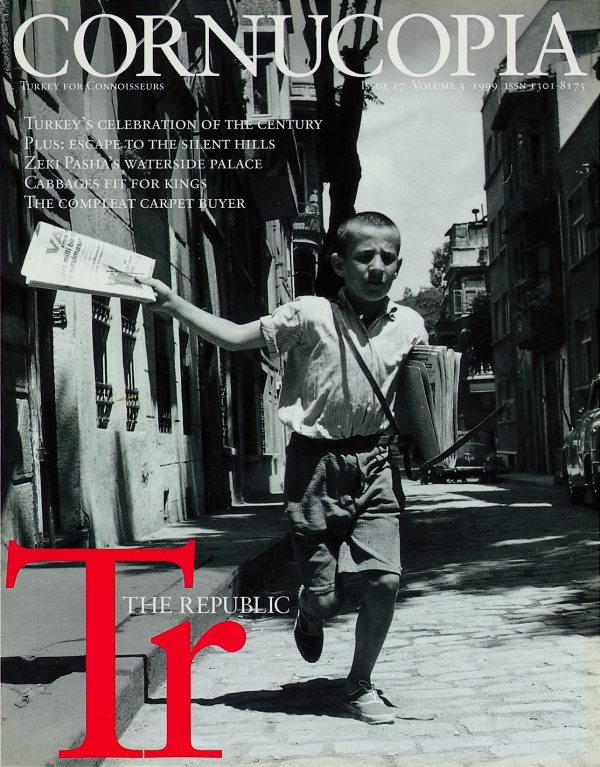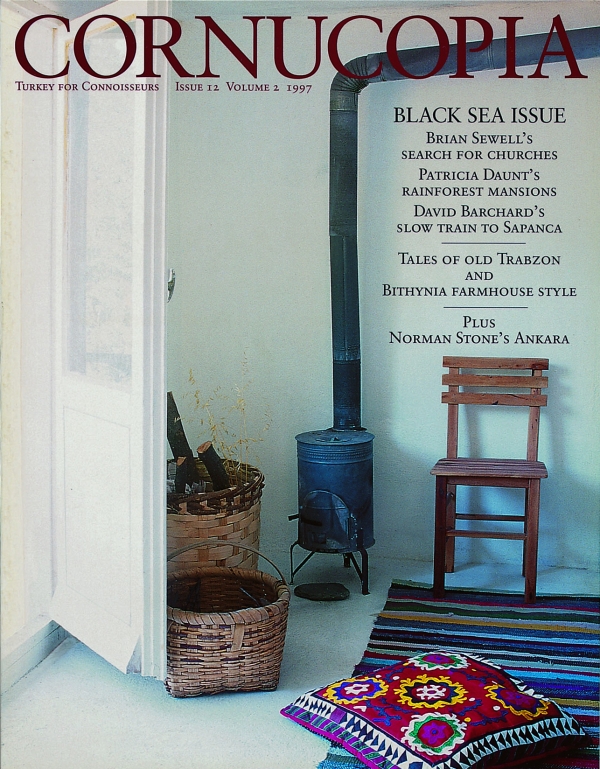Buy or gift a stand-alone digital subscription and get unlimited access to dozens of back issues for just £18.99 / $18.99 a year.
Please register at www.exacteditions.com/digital/cornucopia with your subscriber account number or contact subscriptions@cornucopia.net
Buy a digital subscription Go to the Digital EditionThe sweetmeat of kings, the fuel of warriors, spinach is bursting with colour. The brighter, tangier purslane is a delight still waiting to conquer the West. Berrin Torolsan eats greens with relish
From a 1943 Turkish cookery book by Bahri Özdeniz: “My dear mother washes her spinach leaves with her saintly white hands in several changes of water, then leaves them to drain in a colander, all nicely chopped. Humming the tune of an old song, she finely chops an onion, lights the stove, wipes clean her pan once more and heats some of her delicious-smelling fat and adds the spinach and onion, stirring gently with a wooden spoon as she lightly fries them. She then mixes a crushed clove of garlic and salt into thick creamy yoghurt and pours it over the spinach. I used to jump with excitement when this dish arrived at the table. Prepared like this, spinach adds life to one’s life…”
A friend gave me this quotation many years ago. How, I wondered, could such a simple dish generate such enthusiasm? The cookery book it came from, published in 1943, is not a manual for cooking. It is not selling anything. It is all about the sheer love of food.
Further praise comes from a book written by an anonymous gourmet two centuries earlier, in 1764. Under Isfanak (spinach), there is just one recipe: “They make endless dishes with spinach, but this is the most delectable. First boil the spinach briefly, then squeeze it dry and mince it. Fry a sliced onion in oil and add the spinach. Mix in three beaten eggs, season with salt and pepper. Reduce the flame, and cook, covered, until the base is golden. Turn it over and fry the other side. If you wish,” he adds, “add a little minced meat. This is a fine dish indeed.” This omelette must have been a great favourite to have caused the writer to ignore all other spinach delicacies.
Spinach (Spinacia oleracea) has been in cultivation since remote times in Anatolia and has many wild, semi-wild and cultivated forms. It is known in the countryside as can otu, “life green”, and the dish prepared with it as ot afl›, “dish of green”. It is not even considered to be a proper vegetable, merely a leafy green – though one that is much loved and appreciated. The urban Turkish word for spinach is ıspanak, derived from the Persian isfanak. In China it is known as “Persian herb”, and the Arabs were possibly responsible for taking it to Spain. Ibn-al Avam, a Moorish landowner in the Vadi al Kabir (meaning “great valley”; Guadalquivir in modern Spain), recorded in the twelfth century that spinach appeared in the gardens of Seville in September.
It took another two hundred or so years for it to reach Spain’s northern neighbours. In France it became a luxurious ingredient for banquets, presented in sweet little tartlets and pies prepared with honey and raisins. Its brilliant green colour was used to colour jellies and it was sold in patisseries. Spinach is still used by pastry chefs as the best natural food colouring.
It was not until the sixteenth century, when Catherine de’ Medici introduced spinach to France on her arrival from Florence as the bride of Henri II, that it was recognised as a food in its own right and entered the northern European culinary repertory; any dish with spinach is still à la florentine.
Popeye made canned spinach popular for the modern market, but its magical powers were already known to the warriors of the steppes, from the Crimea to Turkmenistan, where spinach grows wild. It may be a simple leafy green, but it is rich in vitamins, minerals and chlorophyll, a muscle-builder, healer and health-giver. “And spinach contains phosphorus,” said the French phytotherapist Maurice Mességé in the 1960s, long before alternative medicine was in vogue. “It should be an indispensible part of the diet of intellectuals.” In Ottoman Turkey, medrese students and patients convalescing in hospital received a daily ration of spinach. And it must frequently have been on the menu of the sultan, judging by the palace kitchen accounts of 1473.
Spinach, like its relative the beetroot, appears in Istanbul in early autumn. The leaves are collected with their roots and sold in bunches. Numerous recipes suggest that this vegetable, enjoyed all winter long, has always been a staple. But spinach is not the only “life green”. There is another, equally sought-after staple. Purslane may not yet have conquered Western kitchens, where it is still considered a pot herb or salad herb, but in Turkey it is cooked as a vegetable in huge quantities. It has a more pronounced sorrel-like taste than the slightly earthy spinach, which it replaces in early spring. Supplementing the diet all summer, it finally goes to seed in the autumn, when spinach takes over once again.
Purslane, Portulaca oleracea, is entirely at home in Turkey. It is easy to recognise the fleshy stalks bearing a rosette of succulent round leaves and, in early autumn, tiny yellow flowers. As a vegetable it self-seeds effortlessly all summer and is very resilient. It grows as a weed in gardens, in vegetable beds and empty flower pots, but the cultivated varieties have larger, juicier leaves and upright stems. The opaque leaves are sometimes a deep vibrant green, sometimes a yellowish green with a shimmering of gold dust. They are sold in huge quantities in Istanbul’s street markets, the earth still clinging to their roots.
As a child, I always associated the Turkish name, semiz otu, with its fleshy succulence. Semiz means “well nourished”, like a plump pigeon. In the light of recent studies and modern biochemical research, purslane has indeed proved to be one of the most nutritious of plants. It contains fatty acids that help prevent heart disease, and it strengthens the immune system with its high content of vitamins and minerals. It is a purifier and a good source of vitamin C, calcium and iron.
I had come to conclusion that the Turkish semiz actually comes from its substantive and nourishing properties. However, as I prepare this article, an elderly lady tells me that semiz otu was actually so called because it was given to people who needed to lose, not gain, some plumpness after the long, idle winter months. “At least,” she added, “that is what we were always told by our elders.” It makes sense. Assuming purslane has been around a very long time, it is quite possible that in the Middle Ages young men went up into the mountain pastures in spring to get back into shape before going off on campaign. Eating purslane helped them to lose weight and build up their strength at the same time. Was purslane itself nourishing, or was it good for the overnourished? We must wait for the experts’ verdict, for it still seems to be a relatively little-known plant.
Yet purslane was familiar to Pliny the Elder in 1 AD. In his encyclopedic Natural History, he refers to it as Herba portulaca. The eleventh-century lexicographer Mahmut al Kashgari lists the adjective bortulak in his glossary of the Turkic languages as meaning “sprinkled with gold dust”. Could this be the origin of the word “portulaca”? The Swiss botanist Candolle hesitantly refers to its link with Asiatic peoples without drawing any firm conclusion.
Writing in Spain in the twelfth century, Ibn-al Baitar, the Moorish scientist and pharmacologist from modern-day Malaga, hailed purslane as the most beneficial vegetable. Not much later, in the second half of the twelfth century, Ibn-al Avam, who was also from Moorish Spain, advised: “Sow early domestic purslane now, in January, to be eaten in spring…”
After some delay, like spinach, purslane was established as a herb in the princely gardens of France in the fourteenth century, possibly brought back by the crusaders and used for medicinal purposes. They called it purpier, borrowed perhaps from the Armenian word pirpri or pirpirum, a word still commonly used in eastern Turkey. By 1651 it was finally classified as a plante potagère, a proper cooking vegetable, in Le gardinier français.
In the eighteenth century, the British explorer James Cook, on his way to claiming the east coast of Australia and circumnavigating New Zealand, is said to have used purslane to prevent scurvy on long sea journeys.
In Turkey both spinach and purslane were recommended by the physician H›z›r Hac› Paa in the fifteenth century. Using the words that we recognise today, isfanak and semüz oti, he wrote in his book of medicine: “These greens are cooling and digestive and exceedingly good sustenance.” Over and over again, he prescribed the fresh juices, soups and stews made from them as a restorative and as part of a healthy diet. Folklore and modern medicine confirm his wisdom.
The most important point to remember is that both spinach and purslane, with their delicate textures, should be extremely fresh. Never buy sorry-looking wilted leaves, and cook as soon as possible, without storing or freezing. In their preparation, these greens require kindness to preserve their flavour and goodness. They should be simmered briefly or gently stir-fried. It is sounder to undercook them.
ISPANAKLI YUMURTA
Spinach with Eggs
250g spinach
1 tablespoon butter
1 onion (finely chopped)
Salt, sugar and pepper
2 eggs
Even without eggs, sautéed spinach, or Ispanak Kavurması, is a dish in its own right, listed in 15th-century Topkapı Palace kitchen records.
1 Wash, drain and shred the spinach.
2 Melt the butter in a skillet and sauté the onion until it is translucent and soft but not caramelised. Add the spinach, a small amount at a time, and stir-fry until wilted and reduced in volume. Season with salt, a pinch of sugar and pepper.
3 With the back of a spoon make two hollows in the centre of the spinach and break an egg into each. Cover and cook on a gentle heat for a further 2 minutes, until the egg whites are set and the yolks clouded. Serve with oven-fresh bread.
ETLİ SEMİZOTU
Purslane Stew
500g purslane
1 tablespoon butter
Onion (chopped)
250g lamb (cubed)
Tomato or tomato paste
2 tablespoons rice (rinsed)
Purslane’s slightly sour edge, which comes from the oxalic acid it contains, perfectly complements the lamb. This is a succulent, tangy stew which is combined with rice and simmers in its own juices.
1 Wash the purslane, chop roughly and leave to drain in a colander.
2 Melt the butter in a deep pan, fry the onion, then the meat until they are browned. Stir in the tomato or tomato paste, add half a glass of hot water and simmer until the meat is tender. Season to taste with salt and continue cooking for another 1–2 minutes.
3 When the meat is cooked, add the purslane, roughly chopped and still wet, a handful at a time. Give a quick stir and cover for a minute, then repeat with the next batch. When all the purslane has wilted, it should not need any additional water. Add salt to taste. Place the rice on top, cover and cook until the grains have softened and expanded. Remove from the heat and gently mix in the rice.
4 Serve hot with fresh bread to mop up the delicious sauce.
ALSO IN THIS ARTICLE…
Recipes for: Ispanak Çorbası (Spinach Soup); Zeytinyağlı Ispanak (Spinach in Olive Oil); Taratorlu İspanak Kökü (Spinach Stems in Walnut Sauce); Kıymalı İspanak; İspanaklı Börek (Pastry with Spinach Filling); İspanak Püresi (Spinach Purée); and Semizotu Salatası (Purslane Salad)
Levnî and the Surnâme, by Esin Atıl, gives a spirited and vivid pictorial narration, from the brush of arguably the greatest of all Ottoman miniaturists, of the last great Ottoman festival. This was held in Istanbul in 1720, with all the splendour and magnificence for which the empire was famed. Christine Thomson reviews the Koçbank publication.
Said to be the world’s oldest continuously inhabited city, Damascus shows the traces of countless rulers, from the Arameans to the French. But it is the Ottomans whose influence is most clearly visible in the old city today. By Brigid Keenan. Photographs by Tim Beddow
Cornucopia was instrumental in reissuing a forgotten novel by Harold Nicolson, set in Istanbul. First published in 1921, Sweet Waters draws heavily on Nicolson’s experience as a diplomat in the city in the 1910s. It is also a highly autobiographical reworking of his courtship of Vita Sackville-West, as a new foreword by their son, Nigel Nicolson, reveals. By Aslı Aydıntaşbaş
It was only to stop a property dealer painting the selamlık blue that the Germen family acquired a Bosphorus yalı to look after. This pavilion, on a glorious stretch of the Anatolian shore, enjoys southerly views all the way to the Topkpapı and sunsets to die for. Patrica Daunt meets the latest owners of this former royal residence
These are the last great heathlands of Eastern Europe, one of the world’s rarest natural habitats. Unless they receive a last-minute reprieve, they will be bulldozed out of existence. Andrew Finkel reports on the dilemma facing the planners in Istanbul. Botanical notes by Andrew Byfield








Cornucopia works in partnership with the digital publishing platform Exact Editions to offer individual and institutional subscribers unlimited access to a searchable archive of fascinating back issues and every newly published issue. The digital edition of Cornucopia is available cross-platform on web, iOS and Android and offers a comprehensive search function, allowing the title’s cultural content to be delved into at the touch of a button.
Digital Subscription: £18.99 / $18.99 (1 year)
Subscribe now